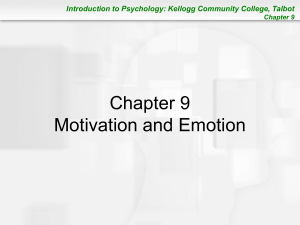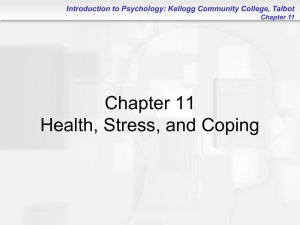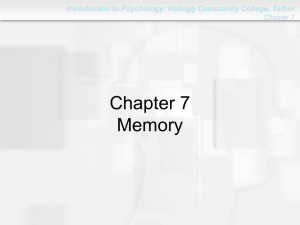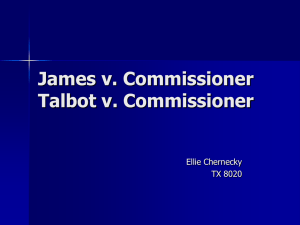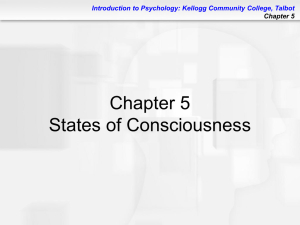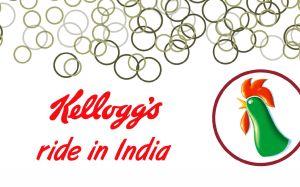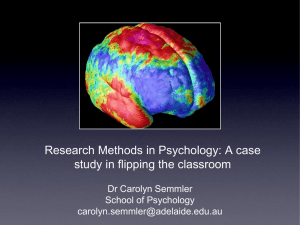Chapter 9: Motivation and Emotion
advertisement
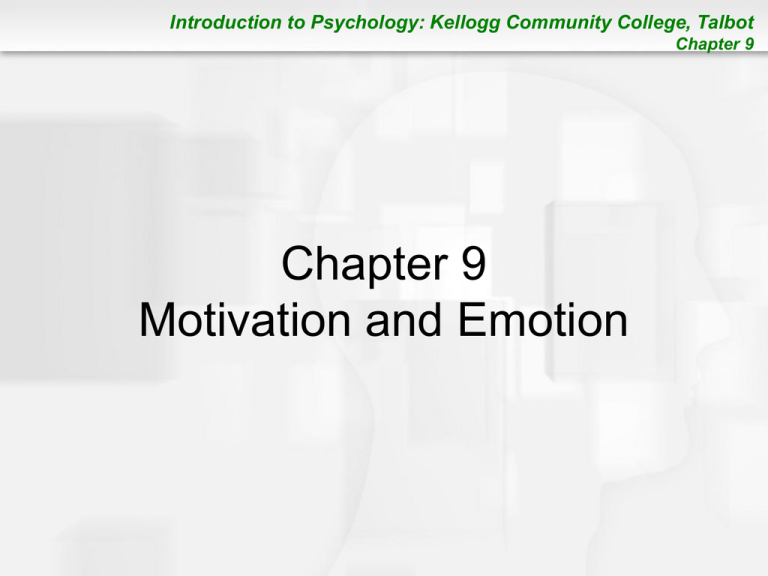
Introduction to Psychology: Kellogg Community College, Talbot Chapter 9 Chapter 9 Motivation and Emotion Introduction to Psychology: Kellogg Community College, Talbot Chapter 9 Motivation Dynamics of behavior that initiate, sustain, and direct or terminate actions Introduction to Psychology: Kellogg Community College, Talbot Chapter 9 A Model of Motivational Activities • Model of how motivated activities work • Need: Internal deficiency; causes • Drive: Energized motivational state (e.g., hunger, thirst); activates a… • Response: Action or series of actions designed to attain a… • Goal: Target of motivated behavior • Incentive Value: Goal’s appeal beyond its ability to fill a need Introduction to Psychology: Kellogg Community College, Talbot Chapter 9 Types of Motives • Primary Motive: Innate (inborn) motives based on biological needs we must meet to survive • Stimulus Motive: Innate needs for stimulation and information • Secondary Motive: Based on learned needs, drives, and goals Introduction to Psychology: Kellogg Community College, Talbot Chapter 9 Hunger: Big Mac Attack? • Homeostasis: Body equilibrium; balance • Influences on hunger • Obesity – Internal • Glucagon-like Peptide 1 (GLP-1): Substance in brain that terminates eating • Hypothalamus: Brain structure; regulates many aspects of motivation and emotion, including hunger, thirst, and sexual behavior – External • External stimuli that tend to encourage hunger or elicit eating; these cues may cause you to eat even if you are stuffed Introduction to Psychology: Kellogg Community College, Talbot Chapter 9 Behavioral Dieting • Weight reduction based on changing exercise and eating habits and not on temporary self-starvation • Some keys – Start with a complete physical – Exercise – Be committed to weight loss Introduction to Psychology: Kellogg Community College, Talbot Chapter 9 Behavioral Dieting (cont'd) • Observe yourself, keep an eating diary, and keep a chart of daily progress. • Eat based on hunger, not on taste or learned habits that tell you to always clean your plate. • Avoid snacks. • Reward yourself if you change eating habits and punish yourself if you do not. Introduction to Psychology: Kellogg Community College, Talbot Chapter 9 Eating Disorders: Anorexia Nervosa • Active self-starvation or sustained loss of appetite that seems to have psychological origins – Control issues seem to be involved – Very difficult to effectively treat – Affects adolescent females overwhelmingly Introduction to Psychology: Kellogg Community College, Talbot Chapter 9 Eating Disorders: Bulimia Nervosa (Binge-Purge Syndrome) • Excessive eating usually followed by self-induced vomiting and/or taking laxatives – Difficult to treat – Prozac approved by FDA to treat bulimia nervosa – Affects females overwhelmingly Introduction to Psychology: Kellogg Community College, Talbot Chapter 9 Causes of Anorexia Nervosa and Bulimia Nervosa • Anorectics and bulimics have exaggerated fears of becoming fat; they think they are fat when the opposite is true! • Bulimics are obsessed with food and weight; anorectics with perfect control. • Anorectics will often be put on a “weight-gain” diet to restore weight. Introduction to Psychology: Kellogg Community College, Talbot Chapter 9 Thirst and Pain • Extracellular Thirst: When water is lost from fluids surrounding the cells of the body • Intracellular Thirst: When fluid is drawn out of cells because of increased concentration of salts and minerals outside the cell – Best satisfied by drinking water • Pain Avoidance: An episodic drive – Distinct episodes when bodily damage takes place or is about to occur Introduction to Psychology: Kellogg Community College, Talbot Chapter 9 Stimulus Drives - Arousal • Reflect needs for information, exploration, manipulation, and sensory input • Sensation Seeking/ Inverted U: Trait of people who prefer high levels of stimulation (e.g., the contestants on “Eco-Challenge” and “Fear Factor”) • Yerkes-Dodson Law: If a task is simple, it is best for arousal to be high; if it is complex, lower levels of arousal provide for the best performance Introduction to Psychology: Kellogg Community College, Talbot Chapter 9 Learned Motives • Social Motives: Acquired by growing up in a particular society or culture • Need for Achievement (nAch): Desire to meet some internal standard of excellence • Need for Power: Desire to have impact or control over others Introduction to Psychology: Kellogg Community College, Talbot Chapter 9 Abraham Maslow and Needs • Hierarchy of Human Needs: Maslow’s ordering of needs based on presumed strength or potency; some needs are more powerful than others and thus will influence your behavior to a greater degree • Basic Needs: First four levels of needs in Maslow’s hierarchy – Lower needs tend to be more potent than higher needs • Growth Needs: Higher-level needs associated with selfactualization • Meta-Needs: Needs associated with impulses for selfactualization Introduction to Psychology: Kellogg Community College, Talbot Chapter 9 Types of Motivation • Intrinsic Motivation: Motivation coming from within, not from external rewards; based on personal enjoyment of a task • Extrinsic Motivation: Based on obvious external rewards, obligations, or similar factors (e.g., pay, grades) Introduction to Psychology: Kellogg Community College, Talbot Chapter 9 Emotions • State characterized by physiological arousal and changes in facial expressions, gestures, posture, and subjective feelings • Physiological Changes: Include heart rate, blood pressure, perspiration, and other involuntary bodily responses • Emotional Expression: Outward signs of what a person is feeling • Emotional Feelings: Private emotional experience Introduction to Psychology: Kellogg Community College, Talbot Chapter 9 Plutchik’s First Four Primary Emotions • Most basic emotions are: – Fear – Surprise – Sadness – Disgust Introduction to Psychology: Kellogg Community College, Talbot Chapter 9 Plutchik’s Last Four Primary Emotions (cont'd) – – – – Anger Anticipation Joy Acceptance Introduction to Psychology: Kellogg Community College, Talbot Chapter 9 Brain and Emotion • Autonomic Nervous System (ANS): Neural system that connects brain with internal organs and glands • Sympathetic Branch: Part of ANS that activates body for emergency action • Parasympathetic Branch: Part of ANS that quiets body and conserves energy – Parasympathetic Rebound: Overreaction to intense emotion Introduction to Psychology: Kellogg Community College, Talbot Chapter 9 Lie Detectors • Polygraph: Device that records heart rate, blood pressure, respiration, and galvanic skin response (GSR); lie detector • GSR: Measures sweating • Irrelevant Questions: Neutral, emotional questions in a polygraph test • Relevant Questions: Questions to which only someone guilty should react by becoming anxious or emotional • Control Questions: Questions that almost always provoke anxiety in a polygraph (e.g. “Have you ever taken any office supplies?”) Introduction to Psychology: Kellogg Community College, Talbot Chapter 9 Body Language (Kinesics) • Study of communication through body movement, posture, gestures, and facial expressions • Facial Blends: Mix of two or more basic expressions Introduction to Psychology: Kellogg Community College, Talbot Chapter 9 Three Types of Facial Expressions • Pleasantness-Unpleasantness: Degree to which a person is experiencing pleasure or displeasure • Attention-Rejection: Degree of attention given to a person or object • Activation: Degree of arousal a person is experiencing Introduction to Psychology: Kellogg Community College, Talbot Chapter 9 Theories of Emotion • James-Lange Theory: Emotional feelings follow bodily arousal and come from awareness of such arousal. • Cannon-Bard Theory: The thalamus (in brain) causes emotional feelings and bodily arousal to occur at the same time. • Schachter’s Cognitive Theory: Emotions occur when a label is applied to general physical arousal. • Attribution: Mental process of assigning causes to events; attributing arousal to a certain source. • Facial Feedback Hypothesis: Sensations from facial expressions and help define what emotion someone feels. Introduction to Psychology: Kellogg Community College, Talbot Chapter 9 A Modern View of Emotion • Emotional Appraisal: Evaluating personal meaning of a stimulus • Emotional Intelligence: Combination of skills, including empathy, self-control, self-awareness, sensitivity to feelings of others, persistence, and self-motivation
